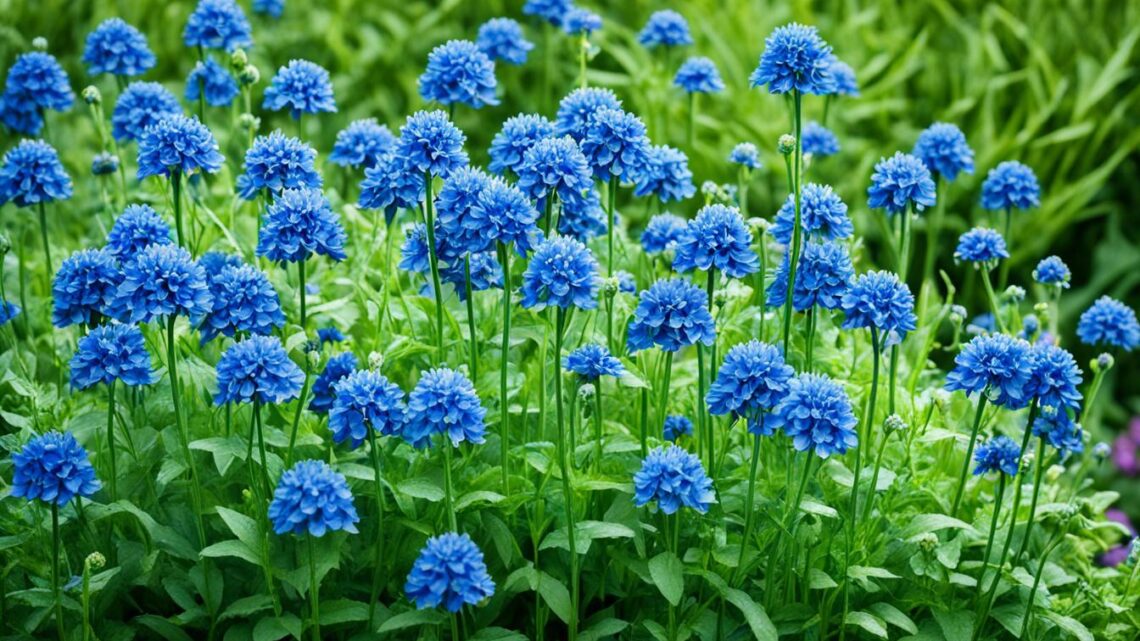
Imagine a world with flowers in deep blues. Instead of the usual red, yellow, or white, you’d see azure, sapphire, and cerulean. Blue flowers are rare, making them special to us. Their scarcity has fascinated botanists, gardeners, and artists for ages. So, what makes these blooms so unique and hard to find?
Experts say the issue lies in the blue pigment. Most plants have green leaves thanks to chlorophyll. But to be blue, plants need a different, complex process. It takes a lot of effort for plants to be blue naturally. Because of this, scientists have had to use genetic engineering to make true blue flowers. Traditional methods were not enough to create the blue beauty we admire.
Blue flowers are special beyond just their rarity. Blue is known to be calming, making these flowers unique in the garden. They also hold special meanings for many. Explore with us, and find out the true magic of blue flowers. See what lies beyond the usual garden colors.
flowers blue: A Rare and Captivating Sight
Blue is a rare and captivating color in nature, especially in flowers. Most plants get their color from the green chlorophyll. But, making true blue flowers is very tough. The article will delve into the difficulty of creating these rare blue flowers. It will also discuss what they symbolize in gardens and more.
The Rarity of Blue Pigments in Nature
The rarity of blue pigments in plants is due to complex processes. These include making the anthocyanin called delphinidin. It mostly shows purple, but with the right mix of co-pigments and metals, it looks blue. Thus, making blue flowers is very hard for plants.
Blue Flowers and Their Symbolic Meaning
Besides their special nature, blue flowers symbolize peace. The color blue is calming. So, blue flowers help make a garden serene. They bring feelings of relaxation and peace. That’s why they’re often chosen for tranquil gardens.
Exploring the Fascinating World of Blue Blooms
Blue flowers are truly captivating with their wide range of shades. They include the elegant blue hydrangeas and the vibrant blue morning glories. Also, the deep blue blue gentians are breathtaking. Each blue flower brings a special charm to gardens or landscapes.
Blue Hydrangeas: Elegant and Versatile
Blue hydrangeas stand out with their big, fluffy clusters of blue blooms. They do well in acidic soil and like some shade. This makes them perfect for gardens, borders, and pots. They range in color from periwinkle to deep indigo, bringing a peaceful vibe to any area.
Morning Glories: Vibrant and Climbing Beauties
The funnel-shaped flowers of blue morning glories are stunning. They are easy to care for and can climb quickly. They cover trellises, fences, and more with their beauty. They are loved for their cheerful nature.
Gentians: Deep Blue Trumpet-Shaped Wonders
Gentians are known for their striking, deep blue, trumpet-shaped blooms. They grow well in cool, moist areas. This makes them a great fit for alpine and rock gardens. Their beauty adds elegance to any space.
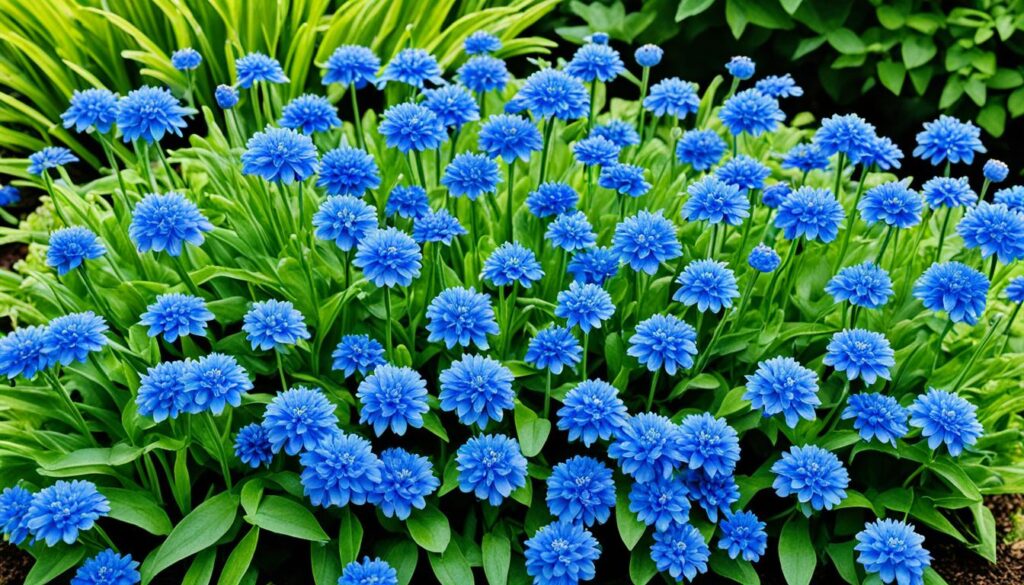
Delightful Blue Perennials for Your Garden
Looking to make your garden pop with color and charm? Think about adding some of nature’s rare blue perennials. Not only do these blue perennials bring a unique calming effect, but they also show off the wide variety and strength of plants.
Balloon Flowers: Star-Shaped Bursts of Blue
Meet the balloon flower. It’s named after its balloon-shaped buds that open into star-like blue blooms. This plant is easy to care for and steals the spotlight in any garden.
Balloon flowers last a long time once cut. They’re great for showing off blue garden plants inside your home.
Bluebells: Enchanting Woodland Delights
The bluebell is another blue perennial worth adding. Its bell-shaped flowers hang in lovely drooping groups, perfect for woodlands. Bluebells bring a bit of magic and grace to gardens, making the space calm and beautiful. They truly highlight how special blue flowers are.
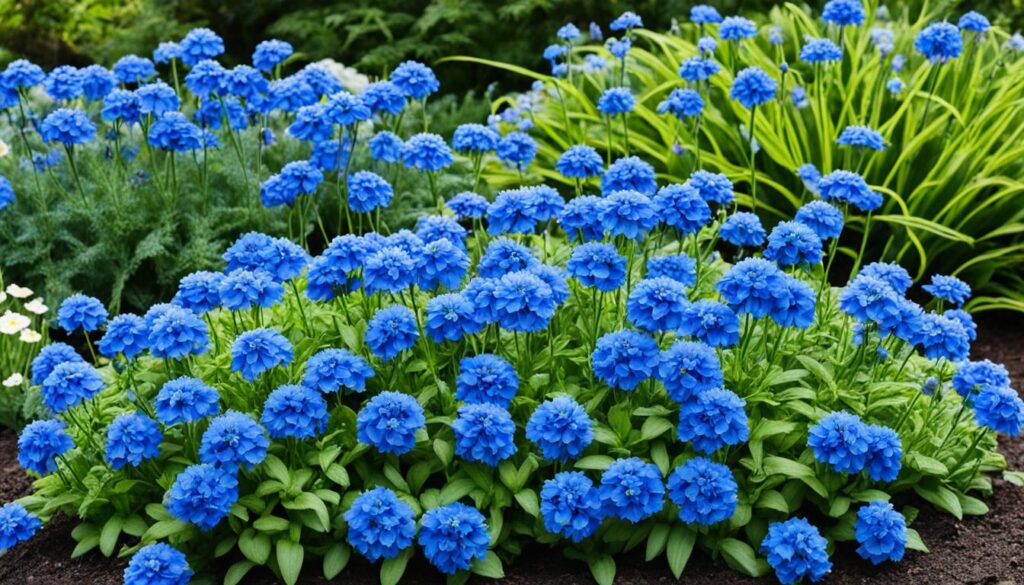
Unique Blue Annuals to Brighten Your Landscape
Blue annual flowers stand out as nature’s rare gems. Finding blue pigments in plants is not easy. Yet, the unique blue flowers you can grow are worth it for your blue garden annuals.
Blue blooms bring a calm and peaceful vibe to your garden. They add a unique beauty that attracts everyone. If you want a special garden with blue annual flowers, they are a perfect choice.
Let nature’s rare unique blue flowers shine in your blue garden annuals. Their beauty and charm will surprise and wow your visitors. With these blue annual flowers, your garden will make a strong and beautiful statement.
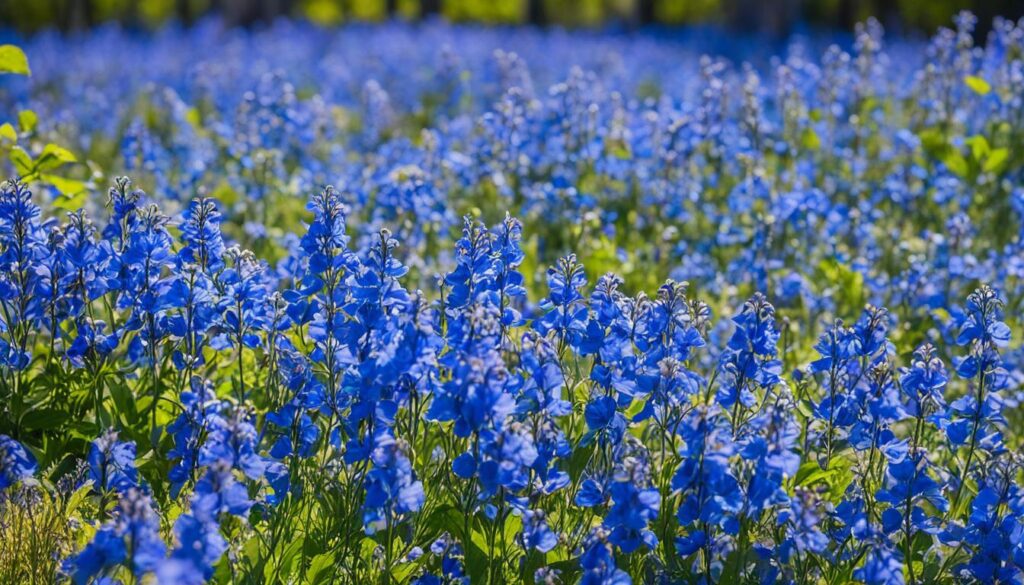
Blue Floral Accents for Borders and Containers
Blue flowers can really make your garden come alive. Whether it’s the blue sage with its sky-blue spikes, or the blue daisies with their cheerful color, these plants offer a unique charm. They bring peace and beauty to any garden setting.
Blue Sage: Attracting Butterflies with Sky-Blue Spikes
Blue sage is a top pick for gardens. It has tall spikes covered in bright blue blooms. These flowers attract butterflies and bees. Blue sage is easy to care for, needing just sunlight and well-drained soil. It brings calm and beauty to gardens or pots.
Blue Daisies: Cheerful Pops of Color
Blue daisies are another great option. Their deep blue petals and yellow center shine brightly. They thrive even in dry conditions. Use them in rock gardens, borders, or pots. Their colors will liven up your garden.
Blue Fescue Grass: A Striking Ornamental Accent
Blue fescue grass offers a more subtle show. It grows in tufts of fine, blue-gray leaves. Perfect for borders, ground cover, or pots, it stands out against green plants. This grass is a versatile and beautiful addition to any garden.
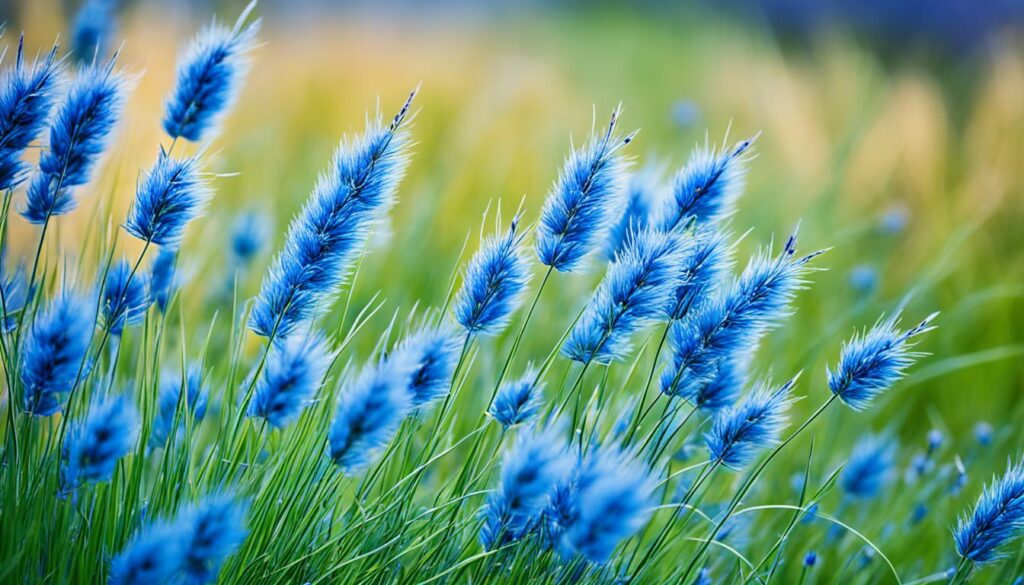
Adding blue flowers doesn’t have to be complicated. You can go for blue flowers for borders, blue flowers for containers, or mix both. By doing so, you’ll turn your space into a peaceful haven highlighting nature’s rare blues.
Exotic Blue Blooms from Around the World
Blue flowers are rare, but some special ones are found in distant places. The tropical passion flower vines in the Americas and the high-altitude poppies in the Himalayas are two examples. These unique blue blooms are a treat for anyone who loves nature.
Blue Passion Flower: Tropical Climbing Beauty
The blue passion flower stands out in warm places. It comes from Central and South America and loves the hot, wet weather. Its blue and white flowers are loved by hummingbirds for their sweet nectar. These flowers are not just beautiful; they are also important in South American traditions.
Himalayan Blue Poppy: A Delicate High-Altitude Gem
The Himalayan blue poppy brings beauty to high places in Asia. It has large, sky-blue petals and a golden center. To grow well, it needs cool, damp air and some shade. This rare flower’s delicate beauty surprises and delights all who see it.
Blue Flowers and Their Fascinating Pollinators
The rare blue color of some flowers is a wonder to many. It interests botanists and nature fans. To attract bees, blue flowers seem more common in places like the Himalayas. These environments are tough and have fewer pollinators. So, blue colors might have evolved as a special signal to these few pollinators.
Luring Pollinators with Rare Blue Hues
Certain flowers use their unique blue color to charm pollinators. Bees, especially, love blue in the ultraviolet color range. They can spot these rare blues from far away. This makes bees crucial in helping many blue plants flourish.
The Science Behind Blue Floral Pigments
Blue flower colors are rare because they’re hard to make. It’s due to complex biological processes and needing a lot of energy. A special pigment, delphinidin, gives flowers purple-blue colors. To look truly blue, flowers must balance other co-pigments and metal ions. This makes the science behind blue flowers and their pollinators even more fascinating.
Creating a Blue-Hued Garden Oasis
Adding blue flowers can turn your garden into a peaceful retreat. These unique blooms help create a relaxing atmosphere. This makes your outdoor space feel calm and open.
Designing with Blue Flowers for Serenity
Blue is known for its calming effects, perfect for a garden escape. Blue flowers like hydrangeas, gentians, and bluebells bring peace. They grow best in shade with well-drained soil, ideal for shaded spots or woodland areas.
Combining Blue Blooms with Complementary Colors
Blue flowers lay the base for a serene garden. Adding warm colors like yellow or pink makes it even more inviting. This mix of cool and warm shades looks beautiful and balanced, creating a stunning paradise.
Caring for Your Blue Floral Treasures
To grow stunning blue flowers, you need to pay close attention to their needs. Start by choosing the right soil conditions. Also, make sure you follow a good pruning and deadheading routine. This way, your blue flower gems will do well and keep your garden beautiful.
Soil Requirements for Optimal Blue Flower Growth
Different blue flowers need special types of soil to grow best. For instance, blue hydrangeas do well in acidic soil. They need a pH level of 5.2 to 5.5 to show off their blue colors. On the other hand, blue gentians like soil that’s moist, well-drained, and full of organic matter. It’s key to plant your blue flowers in soil that meets their specific needs. This is important for their health and blooming year after year.
Pruning and Deadheading for Continuous Blooms
Keeping up with pruning and deadheading helps keep some blue flower types blooming. For example, plants like blue sage and blue daisies need their old flowers cut off. This promotes the growth of new buds. Shaping and thinning through pruning also keeps your blue flower plants looking good and healthy. Regularly doing these tasks means your blue flowers will last for a long time and stay vibrant.
Blue Flowers in Art, Literature, and Culture
Blue flowers have always been treasured for their beauty and rarity. They’re not just admired in nature. They’ve influenced art, literature, and cultural symbols. Artists, writers, and thinkers have often used blue flowers as their muse, capturing the special meaning they hold.
In art, the beauty of blue flowers comes alive on canvas. Artists from various periods have painted them. Some examples include the tranquil landscapes in Texas and the dreamlike works of Impressionists. These flowers symbolize peace, spirituality, and the delicate balance of nature.
In literature, blue flowers hold rich meanings. They inspire and convey deep cultural messages. For example, in German Romanticism, the blue flower symbolizes the search for the ideal and a longing for the divine. In Japanese poetry, morning glories represent brief, beautiful moments and our link to nature.
Blue flowers also play significant roles in cultures and beliefs. Ancient Egypt considered the blue lotus as sacred. Many traditions associate deep blue blue flowers with the heavens and the mystical. They are seen as symbols of purity and tranquility.
The impact of blue flowers goes beyond the natural world. It’s visible in human creativity, spirituality, and culture. Their beauty continues to fascinate and inspire across different fields. This reminds us of the deep beauty and meaning found in nature’s rare colors.
The Future of Blue Flowers: Innovations and Discoveries
Blue flowers are rare and beautiful. It’s exciting to think about what the future holds for them. Because people love blue flowers, experts are looking for new ways to make them. They’re trying to figure out how to find and use the blue pigments in nature.
One way we might see more blue flowers in the future is through science. Already, scientists have made some chrysanthemums turn blue. This shows that other flowers could become blue too. As we learn more about making flowers blue, we might have easy ways to grow them at home.
Also, there are still new blue flowers out there waiting to be found. Botanists and plant experts are on the lookout around the globe. They hope to find rare flowers in nature. When these new flowers are found, they can surprise and teach us a lot about plants.



